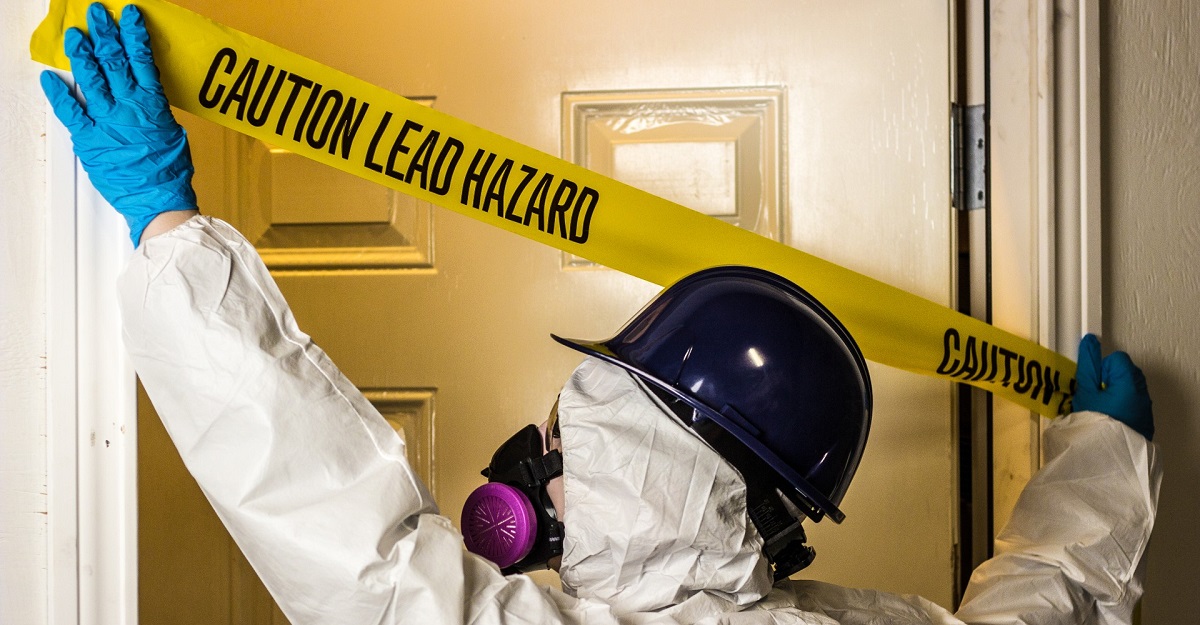Home>Home Maintenance>Lead-Based Paint Hazards: How Many Days Does A Buyer Have To Conduct An Inspection?


Home Maintenance
Lead-Based Paint Hazards: How Many Days Does A Buyer Have To Conduct An Inspection?
Modified: March 6, 2024
Learn about lead-based paint hazards and how many days a buyer has to conduct a home maintenance inspection. Ensure a safe environment for your family.
(Many of the links in this article redirect to a specific reviewed product. Your purchase of these products through affiliate links helps to generate commission for Storables.com, at no extra cost. Learn more)
Introduction
Welcome to the world of home maintenance! As a homeowner, it’s important to understand the various hazards and risks associated with your property. One of the key concerns in older homes is the presence of lead-based paint.
Lead-based paint was commonly used in homes built before 1978. While it provided durability and a smooth finish, it poses serious health risks, especially to children and pregnant women. In fact, the U.S. Environmental Protection Agency (EPA) estimates that about 24 million homes still contain lead-based paint.
When it comes to buying a home, it is crucial for potential buyers to be aware of any lead-based paint hazards. This includes understanding the legal rights and responsibilities surrounding lead-based paint inspections.
In this comprehensive guide, we will explore the regulations and timelines that apply to buyers when it comes to conducting lead-based paint inspections. Whether you are a first-time homebuyer or an experienced investor, this information will ensure you have the knowledge needed to make informed decisions and protect your health.
Key Takeaways:
- Protect Your Health
Before buying a home, ensure you have the right to inspect for lead-based paint hazards. Understanding the risks and taking precautions can safeguard your family’s well-being. - Know Your Rights
Buyers have the right to receive accurate information about lead-based paint in a property. By understanding regulations and timelines, you can make informed decisions and protect your health.
Understanding Lead-Based Paint Hazards
Before diving into the specifics of lead-based paint inspections, it’s essential to have a clear understanding of the hazards associated with this type of paint.
Lead-based paint is a type of paint that contains a high level of lead. It was commonly used in homes and other structures until the late 1970s. This means that if your home was built before 1978, there is a higher likelihood that it contains lead-based paint.
So, why is lead-based paint a concern? The primary issue lies in the potential for lead exposure, particularly for young children and pregnant women. Lead is a toxic metal that can cause severe health problems, even in small amounts. When lead-based paint deteriorates or is disturbed, it can release lead dust or lead-contaminated particles into the air, posing a risk of ingestion or inhalation.
Lead exposure can have detrimental effects on both physical and cognitive development, especially in children. It can lead to learning difficulties, behavioral problems, reduced IQ, and even organ damage. Pregnant women are also at risk, as lead exposure can result in complications during pregnancy and harm the developing fetus.
It’s important to note that lead-based paint hazards are not limited to deteriorating paint. Even if the paint is in good condition, it can still pose a risk if it is disrupted during renovations or repairs. Therefore, it’s crucial for homeowners and potential buyers to be aware of the presence of lead-based paint and take appropriate measures to reduce exposure risks.
Now that we have a basic understanding of the hazards associated with lead-based paint, let’s delve into the rights and responsibilities of buyers when it comes to lead-based paint inspections.
Definition of Lead-Based Paint
Lead-based paint is a type of paint that contains a significant amount of lead as one of its main ingredients. It was commonly used in homes and buildings until regulations were put in place to protect public health and safety.
According to the EPA, lead-based paint is defined as paint that contains lead equal to or exceeding 1.0 milligram per square centimeter (mg/cm²) or 0.5% by weight. This means that even a small area of a wall or surface covered with lead-based paint can potentially expose occupants to harmful levels of lead.
Lead-based paint can come in various forms, including oil-based and water-based paints. It was popularly used for both interior and exterior surfaces, such as walls, doors, windows, trim, and even furniture. In the past, lead was added to paint due to its durability, vibrant colors, and moisture resistance.
Identifying lead-based paint can be challenging since it may be covered with layers of non-lead-based paint. However, when the paint starts to deteriorate or is disturbed, it can become a significant health hazard.
To determine if a paint coating contains lead, specialized testing methods are employed. These tests can be done by professionals using x-ray fluorescence (XRF) devices, chemical spot tests, or laboratory analysis of paint chip samples.
It’s important to note that just because a building was constructed before 1978 does not automatically mean it has lead-based paint. However, it’s always recommended to treat older paints with caution and assume the possibility of lead presence until testing or inspection indicates otherwise.
Knowing the definition and characteristics of lead-based paint is crucial for homeowners, renters, and potential buyers. Whether you are planning renovations or considering the purchase of an older property, being aware of the presence of lead-based paint will help you take appropriate measures to ensure safety and minimize lead exposure risks.
Health Risks of Lead Exposure
Lead exposure, particularly from lead-based paint, can have severe health effects, especially for young children and pregnant women. Even low levels of lead in the body can cause long-term health problems. It’s important to understand the potential risks associated with lead exposure to prioritize the health and well-being of your family.
Children are at the greatest risk of lead poisoning due to their developing bodies and behaviors that may lead them to ingest or inhale lead particles. When children are exposed to lead, it can impact their physical and cognitive development. Some of the potential health risks include:
- Learning Difficulties: Lead exposure has been linked to learning disabilities, decreased academic performance, and difficulties with attention and executive function.
- Behavioral Problems: Children exposed to lead may exhibit behavioral issues such as aggression, hyperactivity, and impulsive behaviors.
- Reduced IQ: Lead exposure can result in a decreased IQ, leading to long-term cognitive impairments.
- Speech and Language Delays: Children with lead poisoning may experience delays in speech and language development.
- Physical Impairments: Lead can also affect physical health, including causing anemia, kidney damage, hearing loss, and growth delays.
Pregnant women are also susceptible to the health risks associated with lead exposure. Lead can cross the placenta and affect the developing fetus, potentially leading to:
- Preterm Birth: Lead exposure during pregnancy increases the risk of preterm birth, which can result in various health complications for the baby.
- Low Birth Weight: Lead exposure has been linked to low birth weight, which can have long-term consequences for the baby’s health and development.
- Developmental Delays: Similar to children, lead exposure in the womb can lead to developmental delays and cognitive impairments.
It’s important to note that the health effects of lead exposure may not be immediately apparent and can manifest over time. Therefore, it’s crucial to take all necessary precautions to prevent lead exposure, especially in homes built before 1978 when lead-based paint was commonly used.
If you suspect lead exposure or have concerns about lead-based paint in your home, it is recommended to consult with a professional, such as a qualified inspector or contractor trained in lead-safe practices, to assess the situation and take appropriate actions to mitigate the risk of lead exposure.
By understanding the potential health risks associated with lead exposure, you can prioritize the safety and well-being of your family and make informed decisions regarding home maintenance and renovations.
Buyer’s Rights and Responsibilities
When it comes to buying a home, potential buyers have certain rights and responsibilities regarding lead-based paint inspections. These rights and responsibilities are in place to ensure that buyers are well-informed about any potential lead hazards in the property they are considering purchasing.
One of the key aspects of a buyer’s rights is the right to receive relevant information about lead-based paint hazards in the property. This is achieved through the seller’s disclosure requirements, which we will discuss in more detail later. The buyer has the right to be informed about any known lead-based paint and any related hazards, as well as any available records or reports regarding lead-based paint in the property.
Buyers also have the responsibility of exercising due diligence in assessing the lead-based paint risks in the home they are interested in. This includes the right to conduct a lead-based paint inspection or risk assessment, which typically involves hiring a certified lead-based paint inspector or risk assessor. The inspection or assessment will determine the presence of lead-based paint, the condition of the paint, and any potential hazards.
It is crucial for buyers to understand that they have the responsibility to arrange and pay for any lead-based paint inspections or assessments. They should also ensure that the inspector or assessor they choose is properly certified and qualified to conduct the evaluation accurately.
Another important responsibility of the buyer is to carefully review all available documentation and reports related to lead-based paint. This includes reviewing the seller’s disclosure forms, any previous inspection reports, and any records of lead abatement or mitigation measures taken in the property.
Furthermore, buyers should consider the information provided by the seller regarding lead-based paint and consult with professionals or experts if they have any concerns or questions. This will allow them to make an informed decision based on their findings and understanding of the potential risks.
It’s important to note that the rights and responsibilities regarding lead-based paint inspections may vary by state or local laws. Therefore, it is recommended for buyers to familiarize themselves with the specific regulations and requirements in their area to ensure compliance and protection of their rights.
By understanding and fulfilling these rights and responsibilities, buyers can navigate the process of purchasing a home with lead-based paint confidently and make informed decisions to protect their health and well-being.
Read more: After A Home Inspection, How Many Days Does A Buyer Have To Ask The Seller To Make Repairs?
Disclosure Requirements for Sellers
When it comes to selling a property, sellers have specific disclosure requirements regarding the presence of lead-based paint. These requirements ensure that potential buyers are informed about any known lead-based paint hazards in the property they are considering purchasing.
Under federal law, specifically the Residential Lead-Based Paint Hazard Reduction Act, sellers of properties built before 1978 must provide certain disclosures to buyers. The law requires sellers to provide the following:
- Lead-Based Paint Disclosure Form: Sellers must provide buyers with a lead-based paint disclosure form known as the “Lead-Based Paint Disclosure.” This form informs buyers about the presence of lead-based paint in the property and any known hazards associated with it. It also provides information about the rights and responsibilities of buyers and sellers regarding lead-based paint.
- Pamphlet: Sellers must also provide buyers with an EPA-approved pamphlet called “Protect Your Family from Lead in Your Home.” This pamphlet provides valuable information about the risks of lead-based paint and offers guidance on how to protect against lead exposure.
In addition to federal requirements, state laws may impose additional disclosure requirements on sellers. Some states have their own specific disclosure forms or additional information that sellers must provide to buyers regarding lead-based paint. It’s essential for sellers to familiarize themselves with the specific regulations in their state to ensure compliance.
It’s worth noting that sellers are not required to remove or remediate lead-based paint hazards before selling a property. The purpose of the disclosure requirements is to provide buyers with information about the presence of lead-based paint so they can make an informed decision regarding the purchase.
If sellers fail to comply with the disclosure requirements, they may be subject to penalties and legal consequences. It’s crucial for sellers to fulfill their obligations by providing accurate and complete information related to lead-based paint hazards in the property and ensuring that the buyer receives the necessary disclosure forms and pamphlets.
By complying with the disclosure requirements, sellers not only fulfill their legal obligations but also contribute to the overall transparency and safety of the real estate transaction. It allows potential buyers to have a thorough understanding of the potential risks associated with lead-based paint and make informed decisions regarding the purchase of the property.
Buyer’s Opportunity to Conduct an Inspection
When it comes to purchasing a property with potential lead-based paint hazards, buyers have the opportunity and the right to conduct a lead-based paint inspection or assessment before finalizing the purchase. This inspection allows buyers to evaluate the presence and condition of lead-based paint and make informed decisions regarding the property.
The buyer’s opportunity to conduct an inspection is crucial in identifying any potential lead-based paint hazards and assessing the overall risk. Here are the key aspects of the buyer’s opportunity to conduct an inspection:
- Contract Contingencies: Buyers can include contingencies in the purchase contract to allow for a lead-based paint inspection. These contingencies specify that the buyer has a specific timeframe to conduct the inspection and review the results before proceeding with the purchase. It’s important to work with a real estate professional or attorney to ensure these contingencies are properly included in the contract.
- Certified Inspectors or Assessors: Buyers have the responsibility to hire a certified lead-based paint inspector or risk assessor to conduct the inspection or assessment. These professionals are trained and qualified to test for the presence of lead-based paint and evaluate any potential hazards. It’s important to choose a reputable and certified inspector to ensure accurate and reliable results.
- Inspection Process: The lead-based paint inspection typically involves visual examination, sampling, and testing of the paint and other surfaces in the property. The inspector may use specialized tools and techniques such as x-ray fluorescence (XRF) devices or collect paint chip samples for laboratory analysis. The inspection process may take a few hours or more, depending on the size and complexity of the property.
- Reviewing Inspection Results: Once the inspection is complete, the buyer will receive a detailed report outlining the findings. This report will indicate the presence, condition, and location of any lead-based paint hazards in the property. Buyers should review the inspection results carefully and consult with professionals if they have any questions or concerns.
- Assessing Risk and Making Decisions: Based on the inspection results, buyers can assess the level of risk associated with lead-based paint and make informed decisions. This may include negotiating repairs or remediation with the seller, requesting a price adjustment, or deciding to proceed with the purchase as is, taking appropriate precautions to minimize lead exposure risks.
By taking advantage of the opportunity to conduct a lead-based paint inspection, buyers can gain valuable information about the property and its potential risks. This empowers them to make informed decisions regarding the purchase and take necessary steps to protect their health and the health of their families.
It’s important to note that the timeframe for conducting the inspection may vary depending on the specific terms and contingencies outlined in the purchase contract. Buyers should adhere to these timelines and ensure that the inspection is completed within the specified timeframe to avoid any complications in the transaction.
When purchasing a home, it’s important to be aware of lead-based paint hazards. In the United States, buyers have 10 days to conduct an inspection for lead-based paint hazards before finalizing the purchase.
Timelines for Conducting an Inspection
When it comes to conducting a lead-based paint inspection, buyers need to be aware of the timelines involved to ensure a smooth and timely process. The timelines for conducting an inspection may vary depending on federal regulations and state laws, as well as the specifics outlined in the purchase contract. Here are some key considerations:
Federal Regulations: Under federal law, sellers of properties built before 1978 are required to provide buyers with a 10-day period to conduct a lead-based paint inspection or assessment. This timeframe begins from the date the seller provides the lead-based paint disclosure form to the buyer. It’s important for buyers to be proactive in scheduling the inspection as soon as possible within this 10-day period to allow sufficient time for the inspection and review of the results.
State Laws: It’s important to note that some states may have specific requirements and timelines for lead-based paint inspections. Buyers should familiarize themselves with the regulations in their state to ensure compliance and to determine any additional timelines or requirements that may apply.
Purchase Contract: The purchase contract may also specify timelines for conducting the inspection. Buyers should carefully review the contract to understand the specific timeframe allowed for the inspection. This timeframe may be different from the federal regulations or state laws. It’s important to work with a real estate professional or attorney to ensure that the inspection timeline is properly documented in the purchase contract.
Once the inspection or assessment has been scheduled within the specified timeline, the actual inspection process may take a few hours or more, depending on the size and complexity of the property. It’s important for buyers to be present during the inspection to ask questions, gain a better understanding of the findings, and discuss any concerns with the inspector.
After the inspection, the buyer will receive a detailed report outlining the findings, including the presence, condition, and location of any lead-based paint hazards. It’s crucial for buyers to review the inspection report thoroughly and seek clarification from the inspector or other professionals if needed.
Based on the inspection results, buyers will then have the opportunity to assess the level of risk associated with lead-based paint and make informed decisions. This may include negotiating repairs or remediation with the seller or requesting a price adjustment, depending on the severity of the issues identified during the inspection.
In summary, the timelines for conducting a lead-based paint inspection are governed by federal regulations, state laws, and the terms outlined in the purchase contract. Buyers should be proactive in scheduling the inspection within the specified timeframe and review the inspection report carefully to make informed decisions regarding the property.
Federal Regulations
When it comes to lead-based paint inspections, federal regulations play a crucial role in ensuring the safety and protection of buyers and occupants of older homes. Understanding these regulations is essential for buyers and sellers alike. Let’s explore some key federal regulations related to lead-based paint:
Residential Lead-Based Paint Hazard Reduction Act: This federal law, also known as Title X, was enacted in 1992 to address the risks associated with lead-based paint in residential properties. The law applies to properties built before 1978, acknowledging that lead-based paint was commonly used prior to that year. The regulation requires certain disclosures by sellers, as well as the opportunity for buyers to conduct lead-based paint inspections.
Lead-Based Paint Disclosure: Under federal regulations, sellers of properties built before 1978 must provide buyers with a Lead-Based Paint Disclosure form. This form informs buyers about the potential presence of lead-based paint hazards in the property. Sellers are required to disclose any known information related to lead-based paint, including any available records or reports.
Risk of Lead-Based Paint Pamphlet: In addition to the Lead-Based Paint Disclosure, sellers are required to provide buyers with an EPA-approved pamphlet called “Protect Your Family from Lead in Your Home.” This pamphlet provides valuable information about the risks associated with lead-based paint and offers guidance on how to minimize exposure risks.
Ten-Day Inspection Period: Federal regulations grant buyers a 10-day period to conduct a lead-based paint inspection or assessment. This timeframe begins from the date the seller provides the Lead-Based Paint Disclosure form to the buyer. During this period, buyers have the opportunity to hire a certified lead-based paint inspector or risk assessor to evaluate the presence and condition of lead-based paint in the property.
Renovation and Repair Requirements: The EPA also enforces regulations regarding lead-safe practices for renovations and repairs in homes and child-occupied facilities. Contractors working on projects that may disturb lead-based paint must follow specific guidelines to prevent the spread of lead dust and protect workers and occupants from lead exposure. These regulations are in place to ensure the safe handling and containment of lead-based paint during renovation activities.
It’s important to note that federal regulations provide a framework for lead-based paint inspections and disclosure requirements, but individual states may have additional regulations or requirements that buyers and sellers need to adhere to. State laws may encompass additional disclosure forms, assessment protocols, or specific training requirements for contractors.
By adhering to federal regulations, buyers and sellers can ensure transparency, safety, and compliance in real estate transactions involving older properties with potential lead-based paint hazards. The regulations aim to protect the health and well-being of occupants, particularly children and pregnant women, by minimizing exposure risks associated with lead-based paint.
State Laws
In addition to federal regulations, state laws also play a significant role in governing lead-based paint inspections and disclosures. These state laws vary and can impose additional requirements and timelines for buyers and sellers. It’s important to be aware of the specific state laws that apply to your area when it comes to lead-based paint. Let’s explore some key aspects of state laws related to lead-based paint:
Disclosure Requirements: Some states have their own specific disclosure forms and requirements in addition to the federal Lead-Based Paint Disclosure. These state-specific disclosures may provide additional information about lead-based paint hazards or requirements to protect buyers and occupants. It’s crucial for sellers to familiarize themselves with the specific disclosure requirements in their state to ensure compliance.
Inspection or Assessment Requirements: Certain states may mandate additional inspections or assessments related to lead-based paint. These requirements may include specific testing methods, certification of inspectors or risk assessors, or frequency of inspections. Buyers should be aware of any state-specific inspection or assessment requirements and ensure they are followed to meet compliance standards.
Landlord-Tenant Laws: Some states have specific laws that govern lead-based paint disclosures and obligations in rental properties. These laws may require landlords to disclose any known lead-based paint hazards and provide information about lead-based paint risks to tenants. It’s important for landlords and tenants to understand and comply with these laws to ensure the safety and well-being of occupants.
Abatement and Mitigation Standards: State laws may also establish standards and procedures for lead abatement and mitigation. These laws outline the requirements for addressing lead-based paint hazards, including proper containment, removal, and disposal procedures. Contractors and property owners should be familiar with the specific state regulations and follow the appropriate guidelines to ensure safe and effective lead abatement or mitigation measures.
In addition to the specific regulations, states may also provide resources and assistance programs to support lead-based paint inspections, abatement, and educational initiatives. These resources can provide valuable guidance for buyers, sellers, landlords, and contractors in understanding and complying with state laws related to lead-based paint.
It’s crucial for buyers, sellers, landlords, and contractors to be familiar with the state laws that pertain to lead-based paint to ensure compliance and protect the health and safety of occupants. By staying informed and following the relevant state regulations, stakeholders can contribute to the prevention and mitigation of lead exposure risks associated with lead-based paint.
Consequences of Non-Compliance
Non-compliance with lead-based paint regulations can have serious consequences for both buyers and sellers. It’s important to understand the potential repercussions of failing to comply with the necessary requirements and obligations. Let’s explore some of the consequences of non-compliance:
Legal Penalties: Sellers who fail to comply with the federal Lead-Based Paint Disclosure requirements can face legal penalties. These penalties can include fines, lawsuits, and even criminal charges in severe cases of intentional non-compliance. The severity of the penalties may vary depending on the nature and extent of the violation.
Buyer’s Recourse: If sellers fail to provide proper disclosures or misrepresent information related to lead-based paint hazards, buyers have legal recourse. Buyers may have the right to seek damages, cancellation of the sale contract, or even reimbursement for related expenses, such as lead-based paint inspections or mitigation costs. It’s important for buyers to consult with legal professionals to understand their rights and options in the event of non-compliance or issues related to lead-based paint.
Public Health Risks: Non-compliance with lead-based paint regulations can pose significant health risks to occupants, especially children and pregnant women. Failure to disclose lead-based paint hazards or neglecting to mitigate such hazards can result in increased lead exposure, leading to potential health complications. This can have long-lasting effects on the physical and cognitive development of children and can also endanger the health of pregnant women and developing fetuses.
Reputation Damage: Non-compliance with lead-based paint regulations can also tarnish the reputation of sellers, contractors, or property owners. Word spreads quickly within communities and real estate networks, and individuals or organizations known for non-compliance with lead-based paint regulations may face diminished trust, difficulty in future property transactions, and damage to their professional reputation.
Loss of Market Value: Properties that are found to have significant lead-based paint hazards, but have not been properly disclosed or mitigated, may experience a decrease in market value. Buyers may be reluctant to purchase a property with known lead-based paint risks, and financing options may be limited. Non-compliance can lead to financial losses for sellers and a prolonged time on the market.
Non-compliance with lead-based paint regulations not only carries legal and financial consequences but also puts the health and well-being of occupants at risk. It’s essential for sellers, buyers, landlords, and contractors to take these regulations seriously, understand their obligations, and ensure compliance to prevent these potential consequences.
By adhering to the necessary regulations and guidelines, stakeholders can contribute to creating safer living environments, preserve property values, and promote the health and safety of occupants, particularly children and pregnant women, in relation to lead-based paint hazards.
Penalties for Sellers
Sellers who fail to comply with lead-based paint regulations can face various penalties and legal consequences. It’s essential for sellers to understand the potential repercussions of non-compliance to avoid these penalties. Let’s explore some of the penalties that sellers may face:
Fines: Non-compliance with lead-based paint regulations can result in significant fines imposed by regulatory agencies or courts. The specific amount of the fine may vary depending on the severity of the violation, the number of violations, and the applicable laws. Fines can range from hundreds to thousands of dollars.
Lawsuits: Sellers who do not provide proper disclosures or fail to ensure lead-based paint compliance can face legal action from buyers or other affected parties. Lawsuits may seek damages related to lead exposure, costs associated with lead-based paint inspections or remediation efforts, and potential health complications resulting from non-compliance. Sellers may be required to reimburse these costs and may face additional penalties determined by the court.
Negative Legal Consequences: In severe cases or instances of intentional non-compliance, sellers may face criminal charges. These charges can result in fines, imprisonment, or both. Criminal charges can arise when sellers knowingly withhold information about lead-based paint hazards or engage in fraudulent practices related to lead-based paint disclosures.
Contract Cancellations: Buyers who discover non-compliance with lead-based paint regulations and related disclosure requirements may choose to cancel the sale contract. This can result in the loss of the sale and potential financial losses for the seller. Contract cancellations can also be accompanied by legal action seeking reimbursement for costs and damages incurred due to non-compliance.
Reputation Damage: Non-compliance with lead-based paint regulations can damage a seller’s reputation within the real estate community and among potential buyers. Word spreads quickly among buyers, agents, and industry professionals, and sellers known for non-compliance may face difficulty in future property transactions. A tarnished reputation can lead to decreased interest from buyers and prolonged time on the market for future sales.
Financial Loss: Non-compliance with lead-based paint regulations can lead to financial losses for sellers. These losses can occur due to contract cancellations, decreased property value, legal expenses, fines, and potential settlements resulting from lawsuits. Sellers may also face challenges in securing financing or insurance for the property due to non-compliance.
Sellers should take lead-based paint regulations seriously and ensure compliance to avoid these penalties and consequences. It’s important to provide accurate and complete disclosures, conduct necessary inspections, and address any lead-based paint hazards appropriately before listing the property for sale.
By complying with lead-based paint regulations, sellers can protect their financial interests, maintain a positive reputation, and uphold the health and safety of potential occupants. It’s crucial for sellers to seek guidance from legal professionals and real estate experts to ensure they meet their obligations and prevent penalties associated with non-compliance.
Recourse for Buyers
Buyers who encounter non-compliance or issues related to lead-based paint during a real estate transaction have recourse options to protect their rights and interests. It’s important for buyers to be aware of their potential avenues for recourse and seek appropriate actions when necessary. Here are some potential recourse options for buyers:
Legal Action: Buyers have the right to take legal action against sellers who fail to comply with lead-based paint regulations or provide accurate disclosures. Legal action can seek various remedies, including compensation for damages, reimbursement of inspection or remediation costs, contract cancellations, and potential punitive damages. It’s essential for buyers to consult with a qualified real estate attorney to understand their legal rights and options.
Negotiation and Remediation: In some cases, buyers may choose to negotiate with the seller to address lead-based paint issues and reach a mutually agreeable resolution. This may involve requesting repairs or remediation of the lead-based paint hazards, a price adjustment to account for the cost of mitigation, or other appropriate remedies. Buyers should work with their real estate agent and legal counsel to navigate negotiations effectively.
Cancelation of Sale Contract: If sellers are found to be non-compliant with lead-based paint regulations or provide misleading information, buyers may have the right to cancel the sale contract. This allows the buyer to withdraw from the transaction and potentially seek damages or reimbursement for costs incurred as a result of the non-compliance. Buyers should review the terms of the sale contract and consult with legal professionals to understand their rights and obligations.
Seeking Professional Insight: Buyers can consult with experts, such as real estate agents, attorneys, or certified lead-based paint inspectors, to obtain professional guidance and insight. These professionals can provide advice on navigating the situation, assessing the severity of lead-based paint hazards, and understanding the available recourse options. Their expertise can help buyers make informed decisions and take appropriate actions to protect their interests.
Educating Other Buyers: If buyers encounter non-compliance or issues related to lead-based paint, they can share their experiences with others. By raising awareness about potential risks and non-compliant sellers, buyers can help protect future buyers from similar situations. This can be done through online reviews, feedback on real estate platforms, or discussions within community networks to ensure others are well-informed and can take necessary precautions.
Buyers play a crucial role in holding sellers accountable for lead-based paint compliance and ensuring the safety of their potential homes. It’s important to gather adequate evidence, document communications, and seek professional advice when pursuing recourse options. By asserting their rights and seeking appropriate actions, buyers can protect their health, financial interests, and overall satisfaction with their real estate investment.
Conclusion
Understanding lead-based paint hazards and the rights and responsibilities of buyers and sellers is crucial when it comes to home maintenance and real estate transactions. Lead-based paint, commonly found in homes built before 1978, poses serious health risks, particularly to young children and pregnant women.
Buyers have the right to receive accurate information about lead-based paint hazards in a property. This is achieved through the seller’s disclosure requirements, giving buyers the opportunity to conduct lead-based paint inspections or assessments. By exercising due diligence in assessing the potential risks, buyers can make informed decisions and take necessary precautions to ensure their safety.
Federal regulations, such as the Residential Lead-Based Paint Hazard Reduction Act, provide a framework for lead-based paint inspections and disclosures. State laws may also have additional requirements and timelines for compliance. It’s crucial for all parties involved to understand and adhere to these regulations to prevent penalties and protect public health.
Non-compliance with lead-based paint regulations can have serious consequences. Sellers may face fines, lawsuits, contract cancellations, reputation damage, and even criminal charges for intentional non-compliance. Buyers, on the other hand, have recourse options such as legal action, negotiation, and cancelation of sale contracts to protect their rights and interests.
By promoting compliance with lead-based paint regulations, we can ensure the safety and well-being of occupants, especially children and pregnant women. It’s important for buyers, sellers, landlords, and contractors to educate themselves, seek professional guidance, and take necessary precautions to prevent lead exposure risks.
In conclusion, by understanding lead-based paint hazards, complying with regulations, and conducting thorough inspections, buyers can make informed decisions and protect their health. Sellers must fulfill their disclosure obligations and address any lead-based paint hazards appropriately. Together, we can create safer living environments and ensure the long-term well-being of homeowners and their families.
Frequently Asked Questions about Lead-Based Paint Hazards: How Many Days Does A Buyer Have To Conduct An Inspection?
Was this page helpful?
At Storables.com, we guarantee accurate and reliable information. Our content, validated by Expert Board Contributors, is crafted following stringent Editorial Policies. We're committed to providing you with well-researched, expert-backed insights for all your informational needs.













0 thoughts on “Lead-Based Paint Hazards: How Many Days Does A Buyer Have To Conduct An Inspection?”